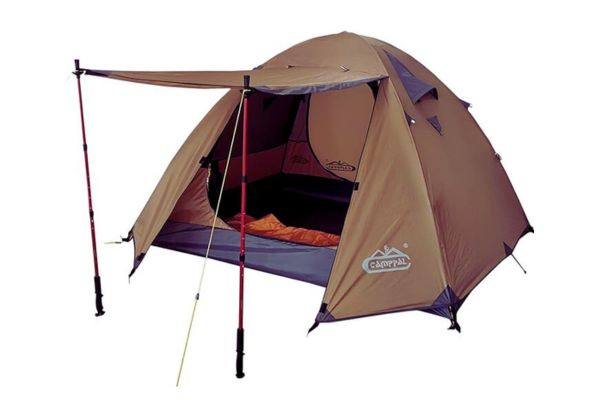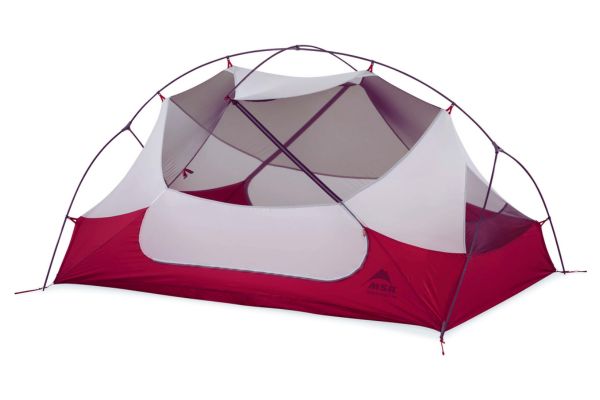If you are on a camping trip and have to deal with bad or windy weather the first thing that comes into your mind is “Can your tent tackle those high winds”? These kinds of weather usually spoil your camping experience if you don’t have compatible camping accessories especially when you are on a solo camping trip in high winds. Let’s Discuss a guide on the best tents for high winds
To manage in windy and rainy weather you need to have tents that withstand high winds keeping you safe and protected whether you are a three-season hiker or a four-season mountaineer. We are here with a guide on the best tents for high winds and tips to remember before making a choice of tents. Have a look!
How To Find The Best Tents For High Winds?
The weather can sometimes be dangerous at the time of camping if you are using inadequate tents and other camping accessories. You need to have the best tents for high winds with all the suitable features. Remember the points described below in finding the best tents for winds:
1. Sturdy Structure
First of all, your tent should be durable in all seasons and weather because high winds contain too much pressure and force which can damage your tent in any sort of manner. Tent poles play a significant role in making your tent stand sturdy in windy conditions. Different tent poles have different features.
Aluminum tent poles in windy weather are quite strong and efficient as compared to other materials and they are easily fixable if high wind blows them away.
Fiberglass tent poles are heavier than aluminum poles. They are good and durable in high wind conditions as they stay stable when forced by winds. If you are going with a tent with fiberglass poles, make sure they have shock cords because it gives them extra strength.
Steel tent poles are generally the best choice for windy camping. These poles do not bend or shatter in high winds or rain as compared to the other two categories. They are heaviest and strong.
2. Stakes And Guylines
If you are planning to camp in windy weather, make sure you have stakes and guylines as these are the essential accessories in setting up a camping tent in such weather which makes things more comfortable. Sometimes these stakes and guylines come with the tent at the time of purchase but they’re of low quality. So, purchase them separately. Make sure to consider V or Y-shaped steel stakes, as these are the best at holding whenever they are placed in the ground in heavy wind weather.
Things to remember:
- Before purchasing your windproof tents for high winds, Make sure your tent has enough anchor points around it so that it can be staked properly.
- When setting up your windproof tent, make sure you have staked and guyed your tent as well as rainfly at every corner.
- Now check that each corner of your tent for high winds is safe and secure.
- Use the guylines at the time of high winds to pull the rainfly taut as it covers your tent otherwise the heavy wind will flap the tent material and destroy it.
3. Material Makes The Difference
To protect yourself and your tent from high winds and heavy rains while camping, you need to choose the tents made up of the best suitable material according to the weather. You can go with fabrics that are ripstop and breathable.
- Polyester and Nylon are the fabrics that work well in such climatic conditions. These fabrics are generally strong, stretchy, cheaper, and damage-proof but are not durable.
- Cotton is a durable fabric. It can hold your canvas tent properly in heavy winds. Cotton-based tent materials are heavy and best-suitable.
- Also, focus on the fabric’s denier rating which indicates how strong and heavy your tent is. This usually tells the thickness of the fiber used in your tent. For example, 20D, 250D Nylon or 500D Polyester. The higher the rating of a fabric, more stronger it will be.
- You may also have seen 190T polyester, 210T poly, etc. This is indicated as the thread count of a material. The thread count should also be considered as it represents the amount of threads found in every square inch of your fabric.
4. Water and UV Resistance
You may experience strong winds with heavy rains sometimes. So make sure your tent is water-resistant and waterproof. It should be able to hold all the water coming from outside. Along with the water resistance feature, your tent should also offer a UV Protection feature as your tent is exposed to UV rays for a long time which can damage your tent and its material. These rays can weaken your tent more and more with every trip you take.
Things to remember:
- Always check your tent fabric’s waterproof rating. This is measured in millimeters which represents the amount of water its material can hold before leaking. For example: 3500mm poly, 2000mm nylon, etc.
- Your tent should be coated with water-repellant spray. Though nylon and polyester are naturally water-resistant, if they do not have a water-repellant coating on them, you must purchase an eco-friendly waterproofing spray and coat your tent with it by yourself. This will increase the lifespan of your camping tent.
- You can also insulate your tent which will keep you warm from inside and save the tent from harsh winds.
5. The Shape Of Your Wind-Resistant Tent
Your tent must be in a shape that handles heavy wind in adverse climatic conditions. Prefer the camping tent which is generally low profile and sleek-looking. These types of tents are considered more wind-resistant as compared to tall ones. Along with durability, tents should have less surface area and are aerodynamic.
Some common tent shapes that offer good wind resistance:
- Dome Tents
- A Frame Tents
- Tunnel Tents
- Geodesic Tents
- Hoop Tents
- Modified dome Tents
6. Ventilation Is Important
Proper ventilation is the most important thing to look for while purchasing a wind-proof tent. Even if there is heavy wind weather outside, there should be proper shelter as well as ventilation inside your take to make you comfortable in such weather.
Things to remember:
- Your tent should have at least two closable vents for adequate ventilation.
- To control airflow, you can go with the zip-lock window tents.
- Make sure the doors and the windows of your tent are closed at the time of heavy winds. If they are not closed properly, you can experience the parachute effect under your tent which can be dangerous.
Read More: How Much Firewood Do I Need For Camping
Top picks of Tents for High Winds
Here are the best tents that include all the features including weight, size, wind-proof/water-proof quality, and many more along with their advantages and disadvantages. Have a look:
1. CAMPPAL Professional 2-3 Person Mountain Tent

- This is the most affordable and top-picked tent for high winds.
- It comes with strong aluminum tent poles that resist high winds.
- All seams are taped and the bathtub floor is 4000mm water resistant.
- It also has a durable, ripstop rain fly (made from 210T poly) that’s 3500mm water resistant.
- This tent is freestanding, super easy to set up, and ultra-lightweight at 8 pounds.
- The floor plan of this tent is 6.9 feet x 5.9 feet, so there’s enough space for 2 campers to fit comfortably.
- This tent has a 4.3-foot peak height and a full mesh ceiling for proper airflow.
PROS:
- Most affordable tent for high winds.
- Lightweight.
- Reflective accents for night visibility.
- Water-resistant bathtub floor and taped seams.
- UV resistant.
- Includes sturdy steel stakes.
- Aluminum tent poles.
- Gear loft, vestibule, and storage pockets.
CONS:
- Rainfly vents don’t seal completely.
2. ALPS Mountaineering Tasmanian 3-Person Tent

- This is the best 4-season Tent For High Winds.
- This shelter is super sleek-looking with a slim and narrow profile.
- The orange rainfly not only looks good but it’s made from 75D 185T polyester.
- It’s highly resistant to rain, UV rays, and wind.
- The aluminum poles that hold the Tasmanian up include a weatherproof shock cord for maximum durability.
- It has closable mesh vents, as well as 2 doors and lots of storage space.
- It includes 2 storage vestibules that are large for the tent’s small size.
- It weighs in at less than 10 pounds, which is great for backpacking.
PROS:
- 4-season tent.
- Lightweight.
- Highly water resistant.
- Aluminum tent poles with shock cord.
- 2 large storage vestibules, storage pockets, and a gear loft.
- Closable mesh windows.
- Freestanding and simple setup.
CONS:
- Tent stakes aren’t the strongest.
3. MSR Hubba Hubba 2-Person Lightweight Backpacking Tent

- This is the most lightweight tent for high winds.
- This tent is backpacker-friendly and extremely lightweight at only 3.5 pounds.
- With 29 square feet of living space and a 39-inch peak height, this is a roomy shelter for 1 or 2 people on a windy day.
- Its tent poles are top-tier, and so is the water-resistant coating.
PROS:
- Most lightweight tent on this list!!
- Super sturdy Easton Syclone tent poles.
- Xtreme Waterproof Coating and stitched seams.
- 2 storage vestibules.
- Color-coded clips for easy setup.
- Built-in rain gutters.
- Includes stakes and guylines.
CONS:
- A bit pricey.
- Could use a few more anchor points.
4. Coleman WeatherMaster 10-Person Outdoor Tent

- This is one of the large tents for high winds.
- This 10-person tent is large enough to fit 3 queen-sized air mattresses and offers over 6.5 feet of head space.
- You can opt for the 6-person version of the same tent.
- The tent poles are fiberglass with strong shock cord support.
- The frame is designed with guy-out triangles and there are plenty of anchor points around the perimeter.
- It has inverted seams, a 1000D polyethylene floor, and a 75D polyester taffeta rainfly.
PROS:
- Huge with a 17’ x 9’ floor plan and a 6’8” peak height.
- Affordable.
- Color-coded poles for easy setup.
- Well ventilated.
- Has an E-Port for power cord access.
- Includes hinged door.
CONS:
- It’s heavy (31 pounds).
- Poor quality stakes included.
5. Kodiak Flex-Bow 6 Person Canvas Tent

- Instead of the typical polyester or nylon tent walls, the Kodiak opts for a much more durable one because it is made up of tightly woven 100% cotton duck canvas.
- This is a much heavier tent (68 pounds to be exact- yikes)
- The material of the canvas maintains breathability to prevent condensation.
- The poles are ultra sturdy and made from spring steel.
- Lots of anchor points around the tent also allow you to stake this thing down to the ground.
- It is luxurious and features a large, D-shaped tent that has doors on the front and rear, each with zippered mesh windows.
- The ceilings are tall at 6.5 feet and 2 funnel-flow vents allow for excellent airflow.
- You also get a large, 72-inch x 78-inch awning as an added touch.
PROS:
- Extremely water-resistant 100% cotton duck canvas with a silicone finish.
- Super spacious.
- Well-ventilated.
- Double-stitched seams and welded corners.
- Includes 12 inch steel stakes.
- Includes gear loft, shelf pockets and large awning.
- Floor made from heavy-duty vinyl.
- Can purchase a 4-person, 6-person, or 8-person version.
CONS:
- Very expensive.
- Very heavy.
Conclusion
Before you go to purchase a camping tent, make sure you remember your specific needs and the climatic conditions of the place where you are heading for camping, wind conditions, and the overall quality of the tent you are going to use there and stay in. You can go with any of the choice of the camping tent discussed above if you want to invest in a high-quality, wind-resistant tent which ensures you a safer and enjoyable camping experience in challenging weather conditions.
FAQs
1. What are some recommended brands for high-wind tents?
Brands like Hilleberg, MSR, Big Agnes, Black Diamond, and REI are known for producing high-quality tents that are often suitable for windy conditions. However, always consider the specific model and features of the tent rather than relying solely on the brand name.
2. Can I use my high-wind tent in normal weather conditions?
Yes, high-wind tents can be used in normal weather conditions. They are designed to be versatile, offering stability and durability in various situations. Just be sure to adjust ventilation accordingly.
3. Should I always close the vents in high winds?
While ventilation is essential, closing vents in extremely high winds can help reduce the tent’s vulnerability to gusts. Choose a tent with adjustable vents that allow you to balance airflow and wind resistance based on the conditions.
4. How can I ensure my tent is securely anchored in high winds?
Ensure your tent is properly staked using quality stakes. Use all available guy lines and tension them appropriately. Position your tent with the narrowest side facing into the wind, and consider using windbreaks if available.
You may also like:

